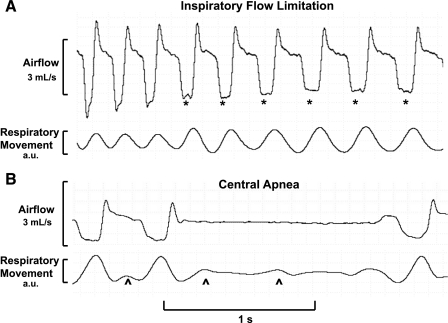Fig. 7.
Recording examples from a WBP study in an New Zealand Obese mouse during sleep. A: a period of progressive decrease in inspiratory airflow. The inspiratory flow contour exhibited progressively broader midinspiratory plateaus (see asterisks), despite increasing inspiratory respiratory movement, consistent with the development of inspiratory flow limitation (IFL). Additional characteristics of IFL include increased respiratory movement swings (compared with earlier breaths), a reduction in maximal inspiratory airflow, an increase in inspiratory time, and negative effort dependence (which can be seen on the first, third, and fifth flow-limited breaths). B: a 1.4-s central apnea characterized by the absence of respiratory flow and movement. Intermittent cardiac artifact (see carets) can be seen in the effort signal.

